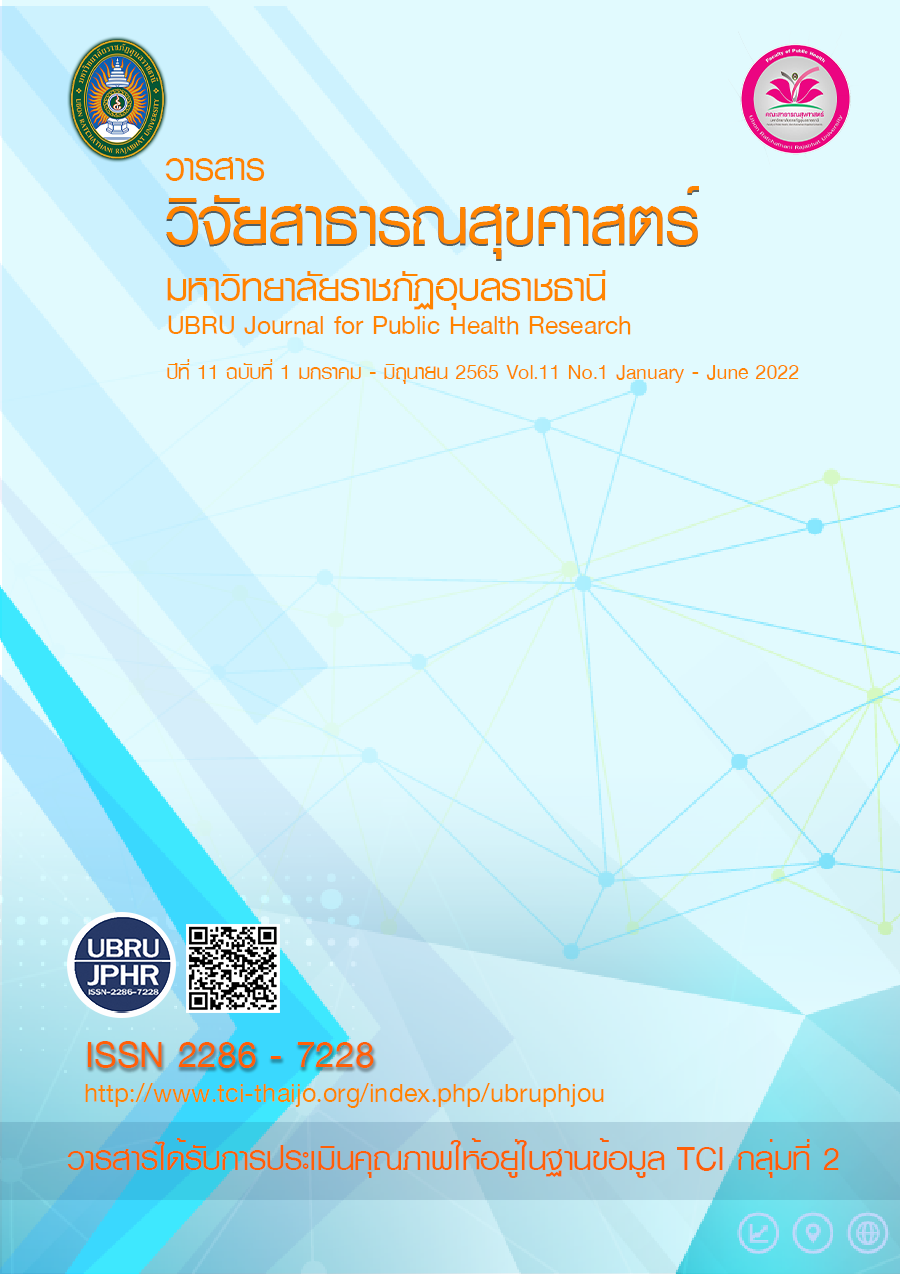Preventive behaviors for COVID-19 in Ban Dok Bua area, Tha Wang Thong Sub-district, Mueang District, Phayao
Keywords:
corona virus; preventive behavior; risk behaviorAbstract
A cross-sectional descriptive study the objective of this research was to study the factors related to the self-protection behavior of people from Corona 2019 infection in Ban Bua area. Tha Wang Thong Subdistrict, Mueang District, Phayao Province, the sample was 242 people aged between 18-40 years. The research instrument was a questionnaire consisting of 6 parts 1) general information, 2) knowledge of coronavirus disease 2019, 3) attitudes towards on coronavirus disease 2019 4) knowledge of laws related to coronavirus disease 2019 5) guidelines for preventing behaviors at risk of contracting coronavirus 2019 6) behaviors to protect themselves from coronavirus disease 2019
The results showed that the percentage of female subjects 62.0 was less than 25 years old, the percentage of income 43.0 was between 5,001-10,000 baht, the percentage of monthly 34.0. A single state, 58.7 percent of Buddhism, 97.1 percent of graduates, and 50 percent of other professions, such as students. 31.0% had no disease, 83.0% were in the north, 76.0% had no history and 98.8% had no disease The percentage of those who did not travel in the danger zone was 98.3. The percentage of those without any symptoms who were detained for 14 days was 95.0 At a high level of knowledge and understanding of the prevalence risk of corona 2019, the percentage was 95.0. Their attitude is at moderate level, with a percentage of 80.6% of their knowledge and law related scrona2019. The results showed that 82.6% of them were risk behaviors prevention guidelines at the level of 50.0%. The results showed that gender, age, education level, education level and preventive behavior were closely related. Income, disease history, attitude the results showed that the significant correlation between risk preventive behavior and preventive behavior was at the level of 0.05. Religion, occupation, status, residence, contact history, travel history, symptoms in the past 14 days. There is no relevant knowledge and law on corona 2019 infection.
Conclusion, People in Ban Dok Bua Village, Tha Wang Thong Sub-district, Muang District, Phayao Province had a moderate level of attitude towards coronavirus disease 2019. The information of this study should be used to plan the management of reinforcement activities. To see the problems and importance of the Coronavirus Disease 2019 in order to create a positive attitude leading to the change in self-defense behavior to control the epidemic to be the most effective.
References
กรมควบคุมโรค. กระทรวงสาธารณสุข. (2563). โรคติดเชื้อไวรัสโคโรนา 2019 (COVID-19). (ออนไลน์). (วันที่สืบค้น 15 เมษายน 2563), เข้าถึงได้จาก: https://ddc.moph.go.th.
ณัฎฐวรรณ คําแสน. (2563). ความรู้ ทัศนคติ และพฤติกรรมในการป้องกันตนเองจากการติดเชื้อไวรัสโควิด-19 ของประชาชนในเขตอําเภออู่ทอง จังหวัดสุพรรณบุรี. วารสารวิทยาลัยพยาบาลพระจอมเกล้า จังหวัดเพชรบุรี, 4(1): 33-48.
ธวัชชัย ยืนยาว และเพ็ญนภา บุญเสริม. (2563). ความสัมพันธ์ระหว่างความรู้ทัศนคติต่อพฤติกรรมการป้องกัน การติดเชื้อไวรัสโคโรนา 2019 (COVID-19) ของอาสาสมัครสาธารณสุขประจำหมู่บ้าน (อสม.) หญิงในจังหวัดสุรินทร์.วารสารการแพทย์โรงพยาบาลศรีสะเกษ สุรินทร์ บุรีรัมย์ , 35(3): 555-564.
ธานี กล่อมใจ ,จรรยา แก้วใจบุญ และทักษิกา ชัชวรัตน์(2563). ความรู้และพฤติกรรมของประชาชนเรื่องการป้องกันตนเองจากการติดเชื้อไวรัสโคโรนา สายพันธุ์ใหม่ 2019. วารสารการพยาบาล การสาธารณสุขและการศึกษา, 21(2):29-39.
พัสกร องอาจ และรัชฎาภรณ์ อึ้งเจริญ. (2564). พฤติกรรมการป้องกันตนเองจากโรคติดเชื้อไวรัสโควิด-19:กรณีศึกษานิสิตมหาวิทยาลัยเกษตรศาสตร์ วิทยาเขตเฉลิมพระเกียรติ จังหวัดสกลนคร. วารสารกฎหมายและนโยบายสาธารณสุข, 7(1):87-102.
รจนารถ ชูใจ, ชลธิชา บุญศิริ และกมลพร แพทย์ชีพ. (2563). ผลของโปรแกรมการส่งเสริมความรอบรู้ด้านสุขภาพในการป้องกันโรคโควิด-19 ต่อความรอบรู้ด้านสุขภาพและพฤติกรรมการป้องกันโรค โควิด-19 ของอาสาสมัครสาธารณสุขประจำหมู่บ้าน ตำบลดอนตะโก อำเภอเมือง จังหวัดราชบุรี. วารสารเครือข่ายวิทยาลัยการพยาบาลและการสาธารณสุขภาคใต้, 8(1):250-262.
รังสรรค์ โฉมยา, กรรณิกา พันธ์ศรี .(2563). ความตระหนักเกี่ยวกับพฤติกรรมการป้องกันการติดต่อโรคไวรัสโคโรนาสายพันธุ์ใหม่ (โควิด-19): การเปรียบเทียบระหว่างวัย.วารสารมนุษยศาสตร์และสังคมศาสตร์ มหาวิทยาลัยมหาสารคาม, 39(6): 71-82.
วิชัย ศิริวรวัจนชัย. (2563). ปัจจัยที่มีผลต่อการปฏิบัติงานตามบทบาทของอสม.ในการเฝ้าระวังและป้องกันโรคโควิด-19 อำเภอภูเพียง จังหวัดน่าน. มหาราชนครศรีธรรมราชเวชสาร, 4(2):63-75.
หทัยรัตน์ สุนทรสุข และนงนวล พูลเกษร. (2563). ระบบการเฝ้าระวัง ควบคุม ป้องกัน โรคโควิด-19 และผลกระทบของการระบาดต่อประชาชน จังหวัดกำแพงเพชร. วารสารสมาคม เวชศาสตร์ป้องกันแห่งประเทศไทย, 11(1):13-29.
ฮูดา แวหะยี. (2563). การรับรู้ความรุนแรงและพฤติกรรมการป้องกันโรคติดเชื้อไวรัสโคโรนา2019 (โควิด-19) ของวัยรุ่นในเขตตำบลสะเตงนอก อำเภอเมือง จังหวัดยะลา. วารสารวิชาการสาธารณสุขชุมชน, 6(4):158-168.
Best, John W. (1977). Research in Education 3rd ed. Englewood Cliffs, New Jersey: Prentice Hall, Inc.
Cronbach, L. Joseph. (1984). Essential of Psychology and Education. New York: Mc–Graw Hill.
Hussein, N. R., Naqid, I. A., Jacksi, K., & Abdi, B. A. (2020). Assessment of knowledge, attitudes, and practices toward COVID-19 virus among university students in Kurdistan region, Iraq: Online cross-sectional study. Journal of Family Medicine and Primary Care,9(9), 4809–4814. doi: 10.4103/jfmpc.jfmpc_870_20.
Likert, Rensis. (1967). The Method of Constructing and Attitude Scale. In Reading in Fishbeic, M (Ed.), Attitude Theory and Measurement New York: Wiley & Son; p.90-5.
McGurnaghan, S. J., Weir, A., Bishop, J., Kennedy, S., Blackbourn, L. A. K., McAllister, D. A., Hutchinson, S., Caparrotta, T. M., Mellor, J., Jeyam, A., O'Reilly, J. E., Wild, S. H., Hatam, S., Höhn, A., Colombo, M., Robertson, C., Lone, N., Murray, J., Butterly, E. (2021). Risks of and risk factors for COVID-19 disease in people with diabetes: a cohort study of the total population of Scotland. The Lancet: Diabetes and Endocrinology, 9(2), 82-93. https://doi.org/10.1016/S2213-8587(20)30405-8.
Taro Yamane. (1973). Statistics: An Introductory Analysis. 3rd ed. NewYork.Harper and Row Publications.
World Health Organization. (2020). Coronavirus disease 2019 (COVID-19). [Internet].
Zhong, B. L., Luo, W., Li, H. M., Zhang, Q. Q., Liu, X. G., Li, W. T., & Li, Y. (2020). Knowledge, attitudes, and practices towards COVID-19 among Chinese residents during the rapid rise period of the COVID-19 outbreak: A quick online cross-sectional survey. International Journal of Biological Sciences,16(10), 1745–1752. doi: 10.7150/ ijbs.45221.
Zhu N., Zhang D., Wang W., Li X., Yang B., SongJ., et al. (2020). A Novel Coronavirus from Patients with Pneumonia in China,2019. N Engl J Med.DOI:10.1056/NEJMoa2001017.
Downloads
Published
How to Cite
Issue
Section
License
Copyright (c) 2022 คณะสาธารณสุขศาสตร์ มหาวิทยาลัยราชภัฏอุบลราชธานี

This work is licensed under a Creative Commons Attribution-NonCommercial-NoDerivatives 4.0 International License.
เนื้อหาและข้อมูลในบทความที่ลงตีพิมพ์ในวารสารวารสารวิจัยสาธารณสุขศาสตร์ มหาวิทยาลัยราชภัฏอุบลราชธานี ถือเป็นข้อคิดเห็นและความรับผิดชอบของผู้เขียนบทความโดยตรงซึ่งกองบรรณาธิการวารสาร ไม่จำเป็นต้องเห็นด้วย หรือร่วมรับผิดชอบใดๆ
บทความ ข้อมูล เนื้อหา รูปภาพ ฯลฯ ที่ได้รับการตีพิมพ์ในวารสารนี้ ถือเป็นลิขสิทธิ์ของวารสารฯ หากบุคคลหรือหน่วยงานใดต้องการนำทั้งหมดหรือส่วนหนึ่งส่วนใดไปเผยแพร่ต่อหรือเพื่อกระทำการใดๆ จะต้องได้รับอนุญาตเป็นลายลักอักษรณ์จากบรรณาธิการวารสารนี้ก่อนเท่านั้น


